It’s winter in Maryland. In fact, it’s so much winter I shoveled 10 inches of snow off my driveway this morning. Fortunately, I had company. It wasn’t the kind of company that picks up a shovel and helps out, but still, the American robins darting back and forth over my head were still welcome (if surprising and surprisingly quiet) snow day companions.
Become a Member
Make a lasting impact for nature when you join The Nature Conservancy
“You know,” I said to them as I leaned on my shovel to watch about 25 birds flock together in my neighbor’s oak. “I think y’all are a little early—aren’t you supposed to be the first harbingers of spring?”
We’re not even a month past the first day of winter in the northern hemisphere. Spring is definitely not here. So why are the robins? Shouldn’t they be sunning themselves in warmer climes?
The short answer: as long as there’s food, American robins—true to their name Turdus migratorius (“the wandering thrush”)—kind of spend their winters coming and going as they please.
Robin Migration (AKA Robin Wandering)
Robins do migrate—but they don’t necessarily follow a more or less straight line from north to south in the fall, then repeat the journey south to north in the spring. In the fall and winter, when the ground freezes, robins lose access to their meal of choice: worms, insects (adult and larval) and (occasionally) snails. That’s when they turn to their winter diet staple: mostly fruit, mostly berries.
The folks at Journey North, a project tracking robin movements run by the University of Wisconsin-Madison, put it this way, “Some robins retreat all the way to southern Texas and Florida (in fact, some of the largest winter flocks documented by the Christmas Bird Count gather in sunny St. Petersburg, Florida), but others winter as far north as they can find berries. So they have an enormous winter range. Robins do migrate, but it has more to do with food sources than with being faithful to the same places year over year.”
In that way American robins are somewhat akin to teenage boys—they tend to go where the best (or most abundant or most easily accessible) food is, stay until it’s depleted, and then move on.
So as long as there are enough berries and other fruits to sustain them, you may see robins off and on throughout the winter across much of North America.
Forget the birdseed though. Robins’ digestive systems, unlike sparrows or other so-called feeder birds, aren’t built for dealing with seed, and their beaks aren’t built for cracking things open. Robin beaks are built for snapping up worms, catching insects, and plucking berries and other fruits. In the winter, a flock of robins can strip a holly bush with impressive speed and efficiency, and very little—if any—violent robin-on-robin aggression.
Food is also one of the reasons that robins, notoriously territorial and aggressive in breeding season, tend to gather and travel in flocks in the fall and winter. Numbers are good for defense, and also for spotting food—if one robin happens on a holly tree full of bright, ripe berries, the whole flock can partake. And then move on.
The tendency of robins to flock in winter may also be one of the reasons people seem to notice them—birds in large numbers tend to stand out when they’re gathered in leafless trees. (That and the beautiful red breast that is sometimes the only splash of color in a winter landscape that looks practically lunar in relentless shades of February white and gray.)
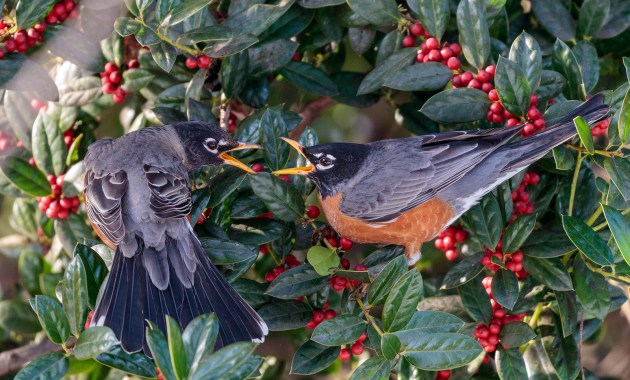
How do Robins Survive the Cold?
Robins are outfitted to survive huge temperature variances. In fact, hot weather seems to stress them more than cold.
If an American robin is healthy, has enough to eat, and is able to main its feathers, the temperature next to its body stays around 104 F—regardless of how cold it is in the world outside. It really is all about those feathers. (And the legs and feet.)
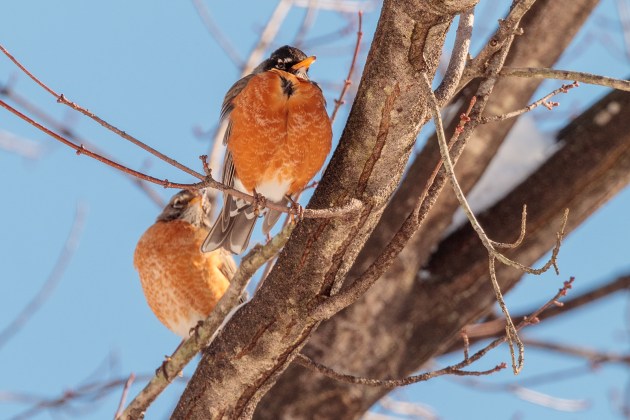
Robins, like most birds, have layers of feathers that perform different functions. When temperatures drop, robins puff the fine, downy feathers closest to their bodies to keep heat in, cold out. The outer feathers act like a kind of overcoat, shedding water and moisture and helping to regulate the bird’s temperature. (It’s an adaptation not limited to robins. Most birds with down feathers fluff them to regulate body heat).
The anatomy of a robin’s (and other bird species) also contributes to their cold adaptations. The bird experts over at the Cornell Lab explain it very well. The simplified version is that “most birds don’t succumb to frostbite because there is so little fluid in the cells of their feet, and their feet are mostly tendons and bones with little muscle or nerve tissue.”
So while blood does flow to their legs and feet, most birds (including robins) benefit from a very fast circulatory system and a “countercurrent heat exchange system.” Because bird legs are thin, the vessels that move blood from the heart to the feet and back again are very close together. That proximity means, per Cornell, “blood flowing back to the body is warmed by blood flowing to the feet. The newly cooled blood in the feet lowers heat loss from the feet, and the warmed blood flowing back into the body prevents the bird from becoming chilled.”
Robins: The Tell-Tale Birds of Spring
If robins are around in winter, why have they always been associated with the beginning of spring in the U.S.? Most likely it has to do with ground thaw, snow melt, and territorial behaviors like singing, worm hunting and nest building. But mostly, it’s the singing.
According to Journey North, which has a fantastic Q+A section I highly recommend for the robin-curious, “the robin’s song remains a reliable indicator that the first wave of spring migration has reached you. This song is one of the first signs that robins are switching from winter behavior to courtship and nesting behaviors associated with spring.”
Robins tend to move north as the ground thaws. The availability of high protein prey, especially worms that emerge with warmer, often wetter weather, is when a robin’s thoughts turn to procreation. And that’s the end of the cooperative fall and winter behaviors.
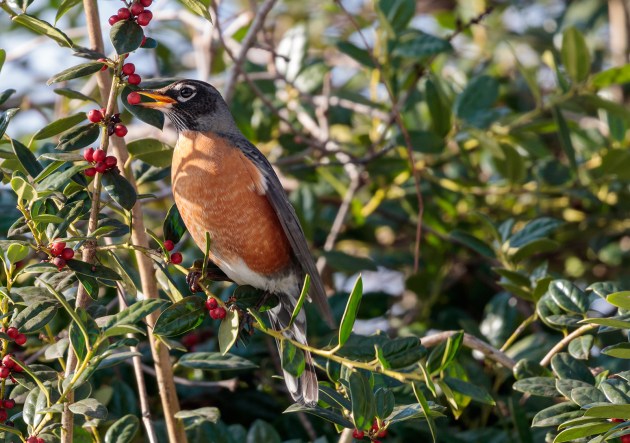
Which is one of the reasons many robins (primarily males) may stay through harsher winters instead of booking it to St. Petersburg: first access to the choicest nesting grounds. Breeding season is when robins also become more visible with mating displays, nest-building and a lot of time on the ground hunting for the tastiest worms. Until then, they’re all about the berries.
You Can Help Robins with Science from Your Own Backyard
Like many species, including other birds, scientists are starting to see some changes in robin behavior that is likely attributable to climate change. One study of American robins migrating to and from Canada’s boreal forest, showed that they’re beginning to journey south on average about 12 days earlier than in past years, or five days earlier per decade since 1994.
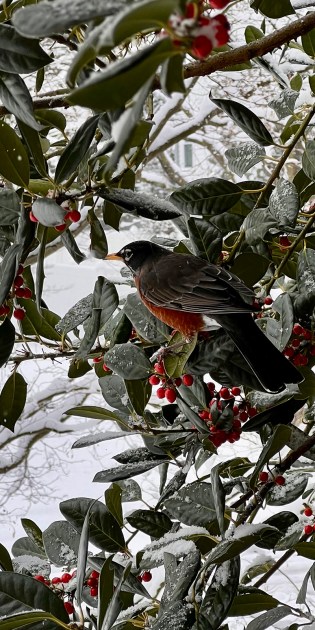
If you want to help scientists studying birds, there are several ways to contribute your observations (not just for robins, but for many of the species you can see outside your windows).
Journey North
You can submit your robin observations directly on the Journey North site (and check out their other migration-related citizen science projects). They also have 2025 maps tracking sightings so you can see where American robins (and other signs of spring) are being observed and follow along (and contribute to) the wanderings of Turdus migratorius.
Cornell Lab of Ornithology
The Cornell Lab has a number of different ways you can contribute to science for birds. Your sightings tracked on eBird (free) contribute to worldwide data for birding, science, and conservation. Want to know what birds are being seen in your neighborhood, eBird has a feature for that. If you’re new to birding, check out their genius birding ID app, Merlin.
You can also contribute to Project FeederWatch (requires subscription) by counting birds at your feeder from November through April. Your observations help scientists monitor changes in the abundance and distribution of birds, including the influence of changes in habitat, disease, and climate.
And mark your calendars for the 2025 Great Backyard Bird Count (February 14-17). Spend time in your favorite places watching birds—then report them to Cornell! It’s easy to participate, “in as little as 15 minutes notice the birds around you. Identify them, count them, and submit your counts to help scientists better understand and protect birds around the world. You can see the results from 2024 here.
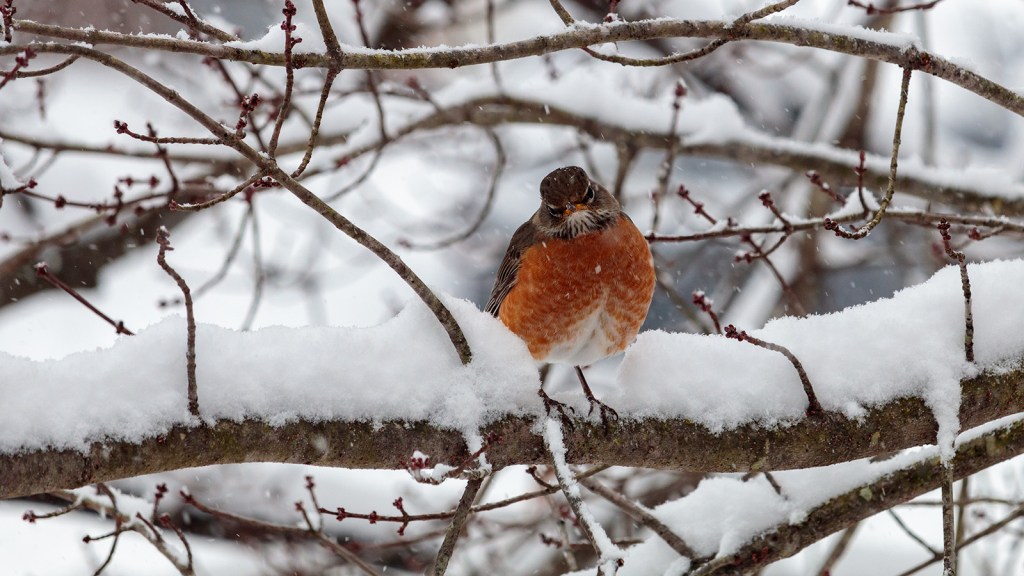



Huge flocks invaded the entire neighborhood mid February. On roofs, trees, in bushes, all over the yard, everywhere. Nice to watch but those birds must think they’re egrets! Crapped all over everything.
We have flocks of Robins in Fort Worth right now. Feb 2021. Our big freeze didn’t slow them down. I understand now, after reading your article, why they looked so big! Beautiful birds!
I live in San Antonio, Texas. I’ve never, ever seen robins before. A few weeks ago we had hundreds, upon hundreds of them. While they are certainly beautiful, the mess that they left behind on all of the cars and patio furniture was disastrous! We had a winter freeze last week, which we haven’t had in over 30 years, and I thought they were gone. But here they are, back again!
During our crazy winter blizzard here in Texas last week we saw hundreds of robins flying through our neighborhood eating berries off our trees. They were beautiful. Mostly males.
During the snowstorm we had in Texas last week, I noticed literally hundreds of Robins all over our three acres. We have several yaupon trees and bushes and they picked them clean of their berries. I didn’t mind at all as it allowed the Robins to get some food. I put out a bowl of fresh water in the front and haven’t seen a single one take advantage of it. We do have a couple of creeks close by. I don’t know if that makes a difference with them, but was thinking they’d like some fresh water. The Robins are back this week, but not in the numbers they were last week. Interesting behavior all the way around. We’ve enjoyed seeing them!
We have seen many robins in Eastern North Carolina this past week and it has been very cold. I usually consider that spring has sprung when the robins appear so I was confused until I read this article!
We had a flock of around 50 robins go across the street and wipe out all the berries in the bushes there that a mockingbird had been defending all winter (we’ve had mockingbirds in those particular bushes for as long as we can remember and we’ve lived here 27 years–they sit on top of a particular whisteria bush as they survey the territory). The poor mockingbird tried to defend his berries by chasing the robins but he was no match for the whole bunch. Since they left, he has come across the street to our feeders, which we are happy to supply with mealworms, suet and other treats. Our problem is that he has now decided our feeders are his territory and is chasing all the other birds away. Luckily, the other birds seem to not pay too much attention.
I’ve been seeing them here since the first part of February here in Genesee County, Michigan….And many others have reported them in their areas too around here……THANX MUCH for the Explanation!!!
So funny I came across this! There have been so many robins in my yard it’s crazy!! There will be 40 of them at once eating the berries in my youpon holly bush. We just had that terrible freeze here in Texas last week and I was so worried they would freeze that I threw bread and set out slightly warm water for them. (So it wouldn’t freeze as fast) Yesterday I noticed two robins going at it! It must have been a territory fight that you mentioned. It got rough! And we keep marveling at how fat the robins are! I figured it was to help them stay warm. It’s all so interesting and beautiful to watch.
Somerset MI, Feb 15th. Noticed a flock of 20 + robins scrounging for insects under a 2ft pile of dried oak leaves. The pile was in the sun and out of the wind, temperature was in the high teens.
We have so many in our backyard every morning even this week when temps were historically below freezing. I’m in Dallas, TX
During this Texas winter freeze, snow on the ground and below freezing temps, I found a group of robins in the snow and under the carport. I threw out cranberries for them and bread it’s peanutbutter on it. Feb 2021. One day a robin came onto the porch to eat wild birdseed.
Saw our first robins yesterday, Feb. 20, in Fort Worth, Texas. Three of them. Right after the multi-day hard freeze (teen temperatures).
I saw roughly 15 Robins on Friday, Feb 19, 2021, in Flint MI on Miller Rd by Genesee Valley Mall. We have quite a lot of snow still and the weather is very cold. It is very odd that they are here this early. Usually after the snow breaks. Late March or early April. Just seems like a weird sign that they are arriving in this cold.
I live in north Texas, Dallas/Ft. Worth area. The number of robins this winter is amazing. I noticed the large flocks about 2 weeks ago. Texas has had an unbelievable winter with extreme lows. The robins flock on the roofs and on the ground. I have never seen so many at one time.